MXA RACE TEST: THE REAL TEST OF THE 2023 YAMAHA YZ250 TWO-STROKE
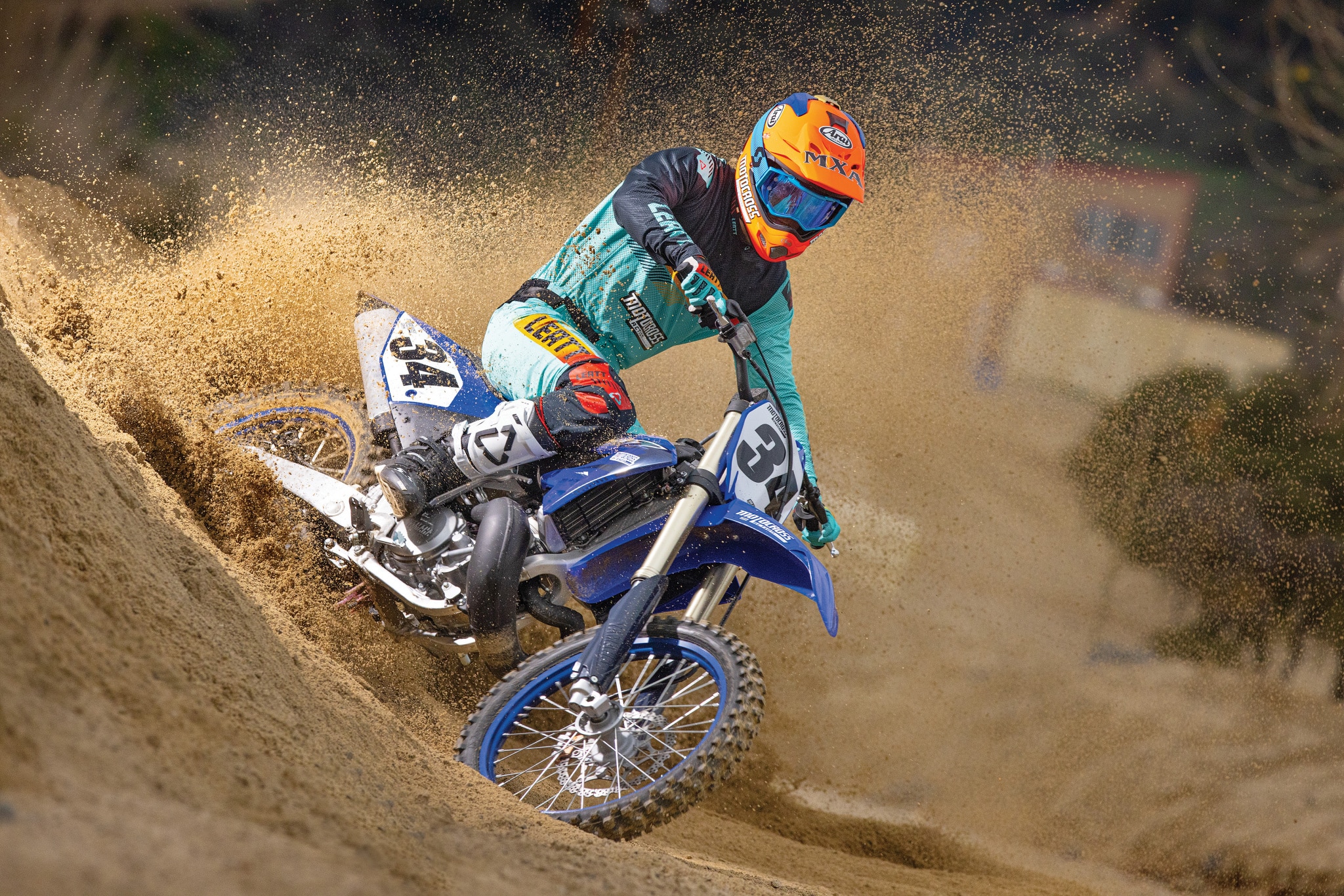
Q: FIRST AND FOREMOST, IS THE 2023 YAMAHA YZ250 BETTER THAN THE 2022 YZ250?
A: No. Its performance is the same as that of the 2022 YZ250 because it is the exact same bike
Q: WHAT PARTS OF THE YZ250 WERE CHANGED LAST YEAR?
A: Here are six areas where Yamaha spent time and money in 2022:
(1) Bodywork. The YZ250’s bodywork got its first update since 2015 when both the YZ125 and YZ250 got the four-stroke’s “arrow” plastic.
(2) Ergos. Along with new plastics comes a new subframe, fuel tank and seat. These three components work together to create a flatter seat profile and an updated “rider triangle.”
(3) Brakes. The YZ450F got updated brakes in 2020 and 2021, and the YZ125 and YZ250 got a brake hand-me-down from the YZ450F.
(4) Suspension. In 2022 the YZ250 got stiffer spring rates and firmer valving. The 2022 YZ250’s Kayaba SSS forks also got a hand-me-down from the YZ450F in the form of a leaf spring in the mid-valve for improved comfort (sort of Yamaha’s version of WP’s Trampoline valve).
(5) Intake. Thanks to the new subframe and bodywork, there is a new airflow pattern to the airbox. There are two air paths that draw fresh air into the airbox from scoops on the rear of the side panels. They redirect air around and under the seat.
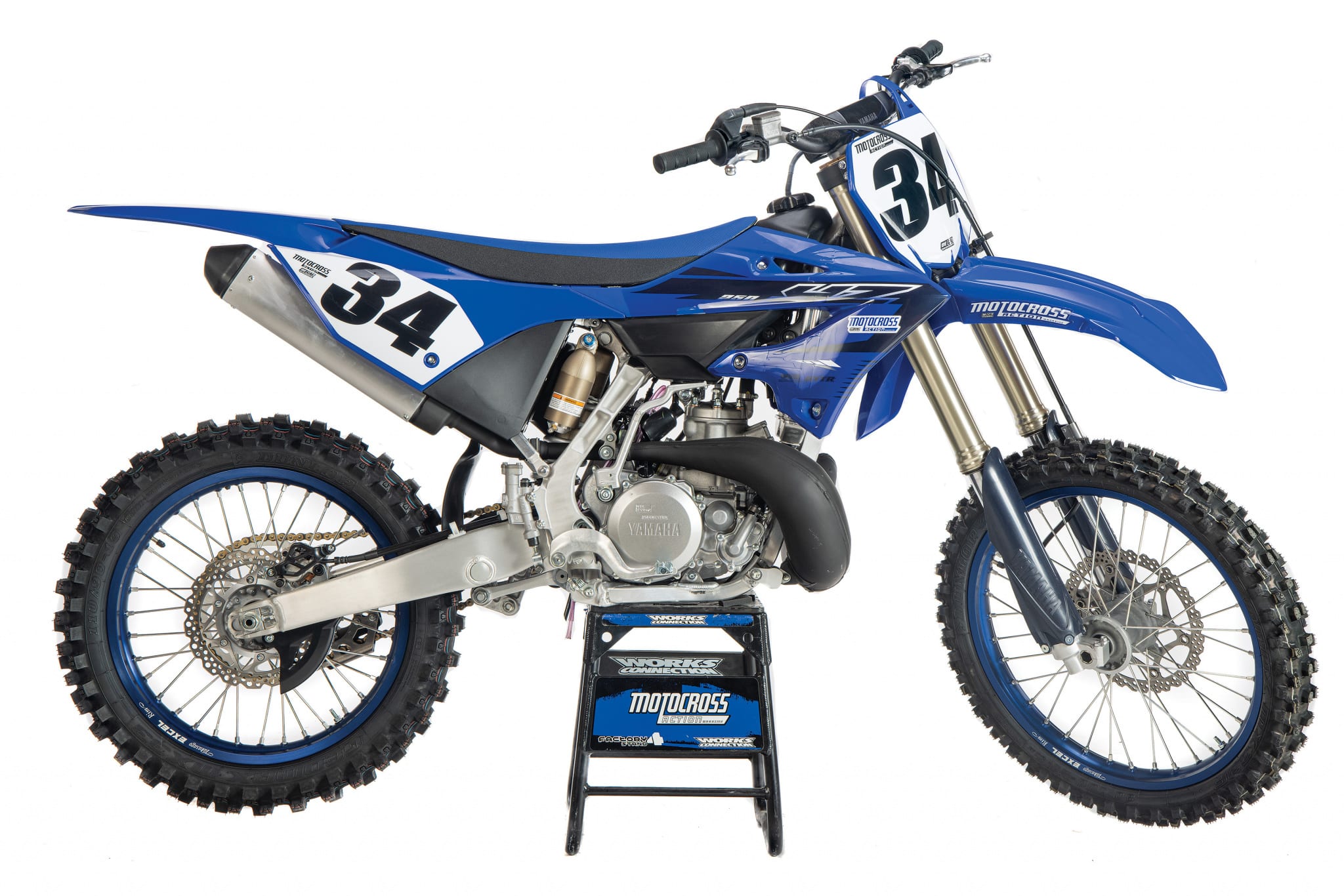
(6) Drive chain. The rear sprocket and chain have been updated to be slightly lighter, and the YZ250 also gained new Dunlop MX33 tires.
Q: HOW ARE THE NEW YZ ERGONOMICS?
A: The previous 2022 fuel tank, radiator shrouds and seat changed the ergonomics of the YZ250. The bike is 36mm narrower at the tip of the radiator shrouds and 7mm narrower in the middle where your knees grip the bike. Additionally, the seat is 5mm taller in the middle and 6mm lower at the front, creating a flatter profile that helps the rider sit “on the bike” rather than “in the bike.”
In motion, the 2023 YZ250’s taller seat height was most noticeable in the pits and when entering corners on the track. Most MXA test riders like the new ergonomics, especially the seat shape, because the previous 2021 and earlier YZ250 seats were kind of sacked out when they were new. The flatter seat shape enabled MXA test riders to slide forward in corners and back on long straights.
The 2022 YZ250 changes to the bodywork and ergonomics were carried over to the 2023 Yamaha YZ450F. The big bike’s spec-sheet notes that the YZ450F radiator shrouds are 50mm narrower, the fuel tank is 6mm narrower, the seat is 5m taller, and the footpegs are 5mm farther back and 5mm lower.
Q: HOW ARE THE NEW BRAKES ON THE YZ250?
A: Two-strokes are much lighter than four-strokes, which makes them easier to bring to a halt, but they also lack a four-stroke’s engine braking, which means you have to rely on the brakes more to slow a two-stroke down. New in 2022, the YZ250 was spec’ed with the same brakes that come on the YZ250F and YZ450F.
The front brake caliper’s piston was enlarged from 22.6mm to 25.4mm, while the caliper’s rigidity was increased by 30 percent. The more rigid caliper improved brake pad contact, because the caliper didn’t flex as much under the pressure of hard braking. The front brake pads have a surface area that is 30 percent greater. The rear brake got a smaller 240mm rotor (down from 245mm in 2021).
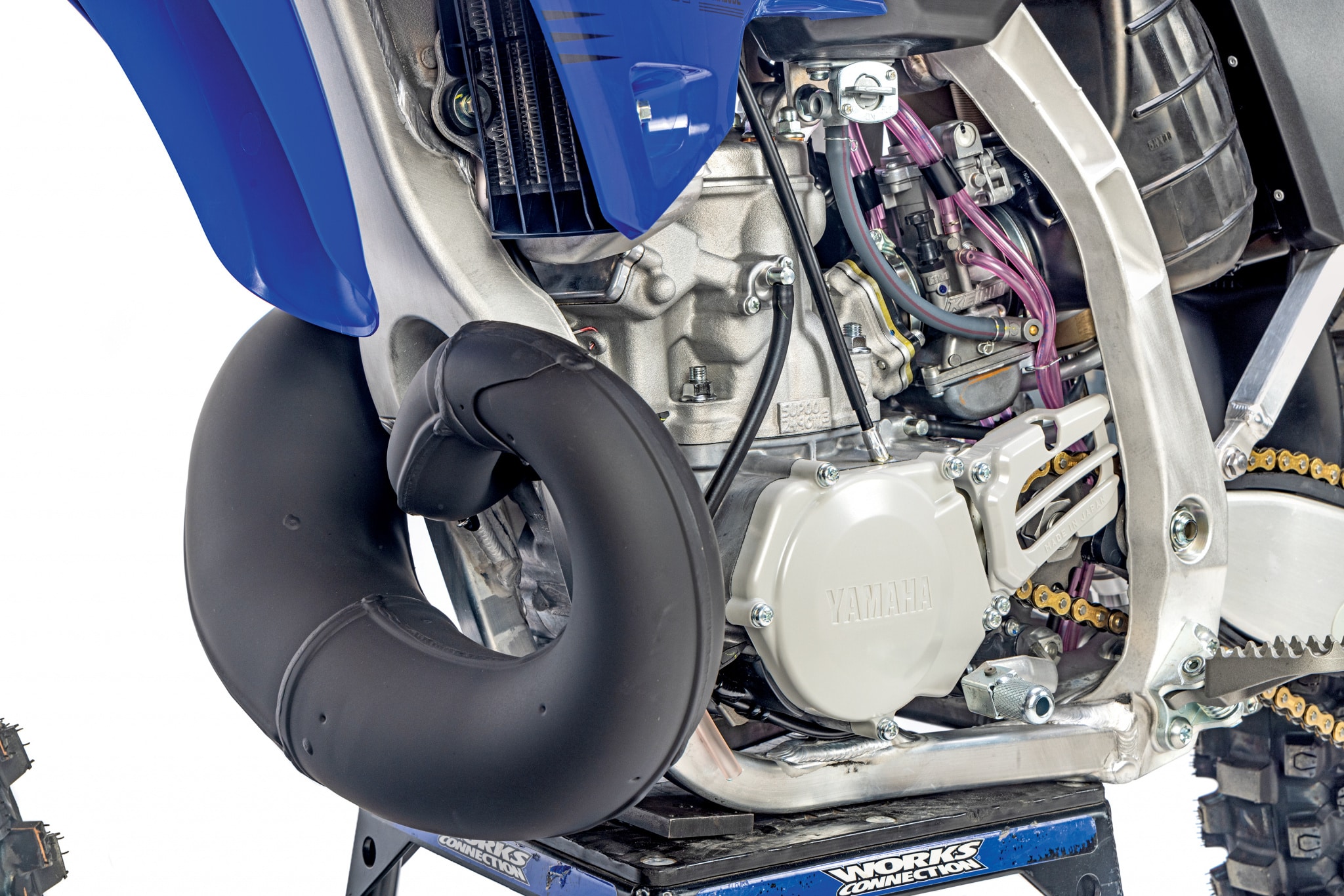
Q: HOW DOES THE YAMAHA YZ250 RUN ON THE TRACK?
A: The Yamaha YZ250 two-stroke is known for being smooth and manageable, while their major competition (KTM) features an aggressive hit and exhibits considerably more torque and midrange power. Tailored more for racing than trail riding, the KTM 250SX hits hard, revs fast and signs off early. On low-to-mid thrust, the KTM displays a much more race-ready amount of power.
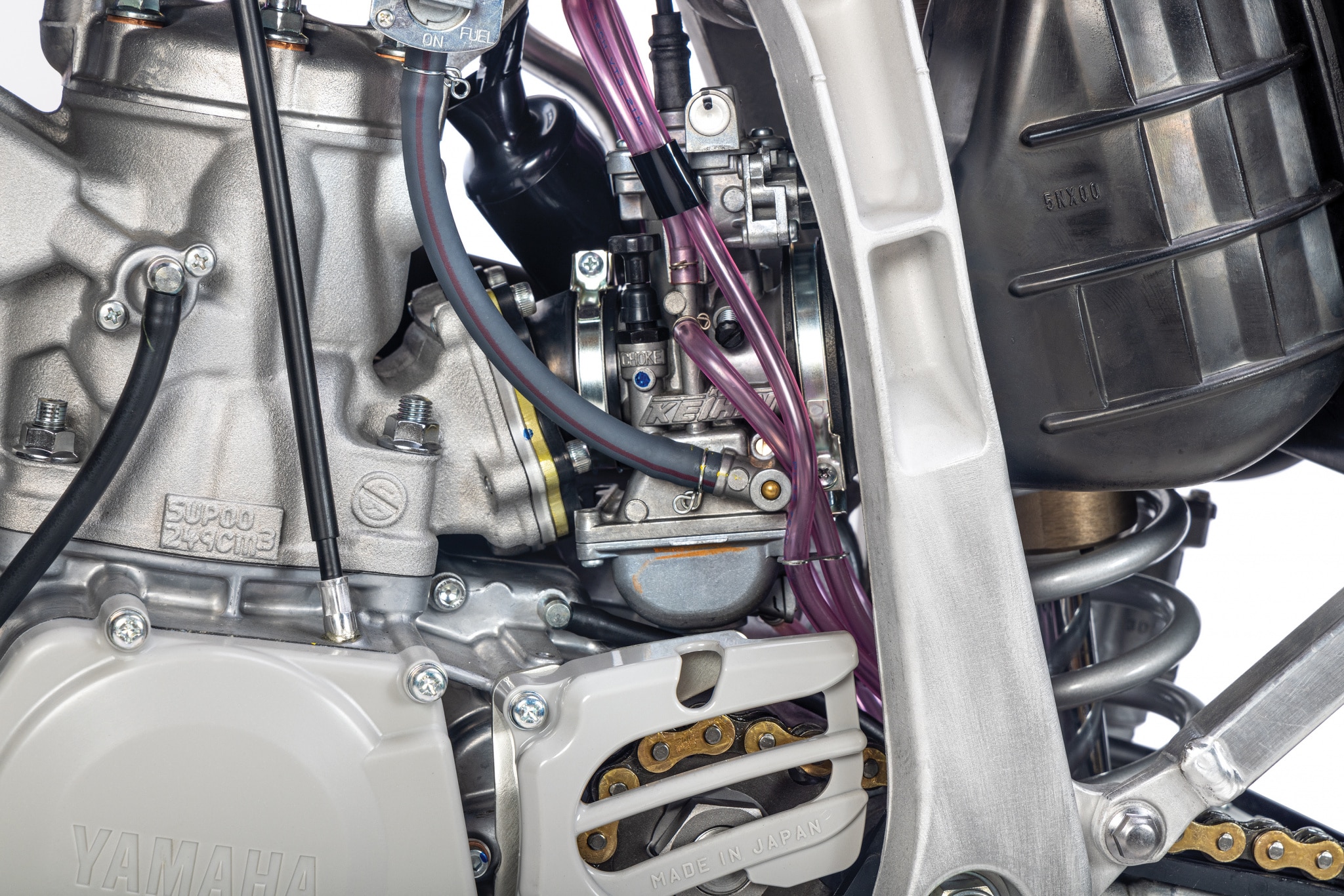
If Yamaha wanted to engage in a horsepower war with the Austrian bike, they would have no choice but to pursue KTM’s stronger pull from idle to the middle, but going all-out to match the KTM 250SX would be a mistake. The Yamaha’s strength lies it its friendlier powerband. We aren’t upset that the Yamaha engineers didn’t increase the compression ratio, raise the ports or alter the power valve timing. Instead, they straightened the intake tract to improve air airflow, but we didn’t think it added much of anything to the powerband in motion. The YZ250 is easier to ride (for a two-stroke) off the crack of the throttle, and it pulls steadily up to the 8800-rpm range. On the track, the 2022-2023 engine feels identical to the 2021 YZ250.
In short, Yamaha and KTM remain in a stalemate. The YZ250 isn’t as powerful from low-to-mid as the KTM, but it is easier to keep in the meat of its mid-and-up rpm range. The KTM 250SX powerband requires more skill in managing throttle, rpm, clutch and shifting, while the YZ250 is easy-peasy.
These two machines are equally matched for two reasons: (1) The KTM 250SX is much more powerful from idle to the point where it signs off. (2) The YZ250 can’t run with the KTM from low to mid, but once the KTM 250SX signs off, the easier-to-ride YZ250 begins to close the gap. How big the gap is depends on rider skill more than cold, hard metal.
Q: HOW DOES THE YAMAHA YZ250 HANDLE?
A: With stiffer spring rates and valving, the MXA test riders went out one click on compression in the fork and shock. Surprisingly, one click made a difference that was appreciated; however, once the YZ250 broke in, the bike began to dive under hard braking. To get more hold-up from the front forks, our faster and heavier test riders slowed down the rebound and turned the compression in until the bike leveled out coming into turns.
Not surprisingly, our Vet test riders missed the softer suspension of 2021. It had always been very comfortable and predictable for lighter, slower and older riders. As always, one of the big pluses of Kayaba SSS suspension is that the SSS forks can easily adapt to a wide variety of skill levels, rider weights and track conditions.
Lately, we have noticed a propensity for product planners trying to seek the approval of Intermediates and Pro riders by going stiffer on the valving and spring rates. If you are an Intermediate or Pro, this is a good thing, but vice versa for the Novices, Vets and play riders. It’s not as criminal on a 250cc two-stroke as it is on 250 four-strokes, where the target audience should be young riders, minicycle transplants and Novices. Two-stroke buyers tend to be older—because older riders appreciate what a two-stroke offers. The biggest stiffness grievances are the 2023 Honda CRF250, Kawasaki KX250 and Suzuki RM-Z250 forks—they are very stiff.
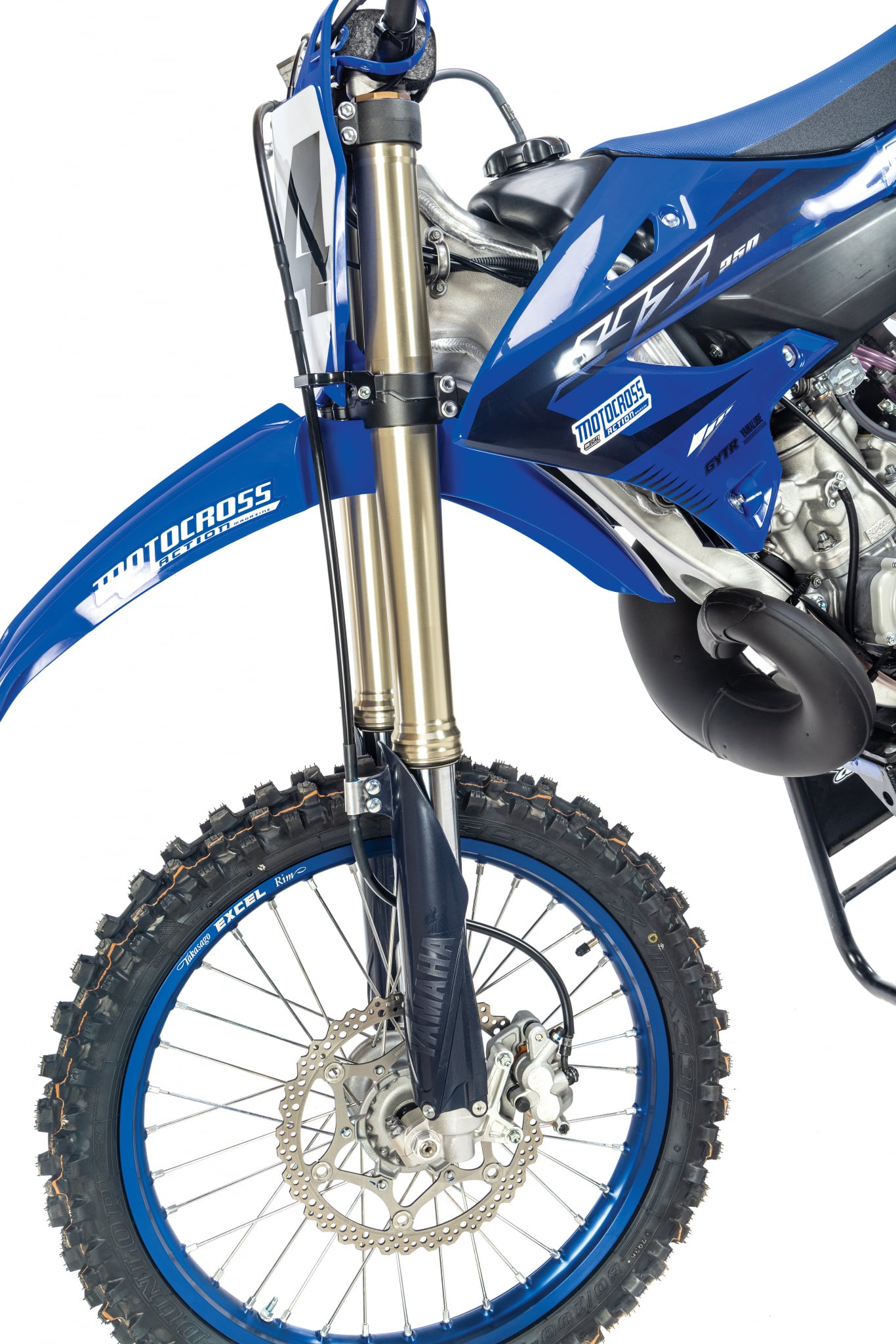
Q: WHAT CAN YOU SWAP OFF OF YOUR OLD YZ250 TO THE 2023 YZ250?
A: You can swap your wheels, forks, shock, linkage, swingarm, triple clamps, reed valve, clutch, carburetor, handlebars and footpegs over from your 2021 or older bike to the 2023 YZ250. You can’t swap the exhaust pipe, silencer, subframe, airbox, seat, fuel tank, radiator shrouds or rear fender.

Q: WHAT DID WE HATE?
A: Here’s a list of things we hated.
(1) Suspension. It’s nice that Yamaha tailored the suspension settings to favor heavier and faster riders, but on the 2023 Yamaha YZ250, lots of riders struggled to find the comfort they were used to. The 2021 settings were softer, but they worked well for the majority of average riders.
(2) Seat height. Yes, we liked that we could move around easier on the 2023 seat, but that did not include shorter riders, who found the taller and flatter 2023 seat to be a nuisance on the starting line and in the corners.
(3) Wheels. Yamaha four-stroke and two-stroke wheels are not interchangeable. This is a bummer for two groups of riders: (1) Riders who own a YZ450F and a YZ250 two-stroke. They can’t use the wheels off one bike on the other in a pinch, like if they get a flat tire right before their second moto. (2) Riders who like to run aftermarket wheels on their YZ250 and YZ-F four-strokes are forced to choose which bike to get spare wheels for. That defeats the spare-wheel gambit. This really isn’t so much a wheel-related issue as it is the fault of the YZ250’s old-fashioned swingarm, which was built for smaller 22mm axles decades ago.
(4) Scoop stress. The rear-facing air scoops in front of the rear fender fast-track water into the airbox when you are washing the YZ250. The best solution is a plastic Twin Air airbox cover.
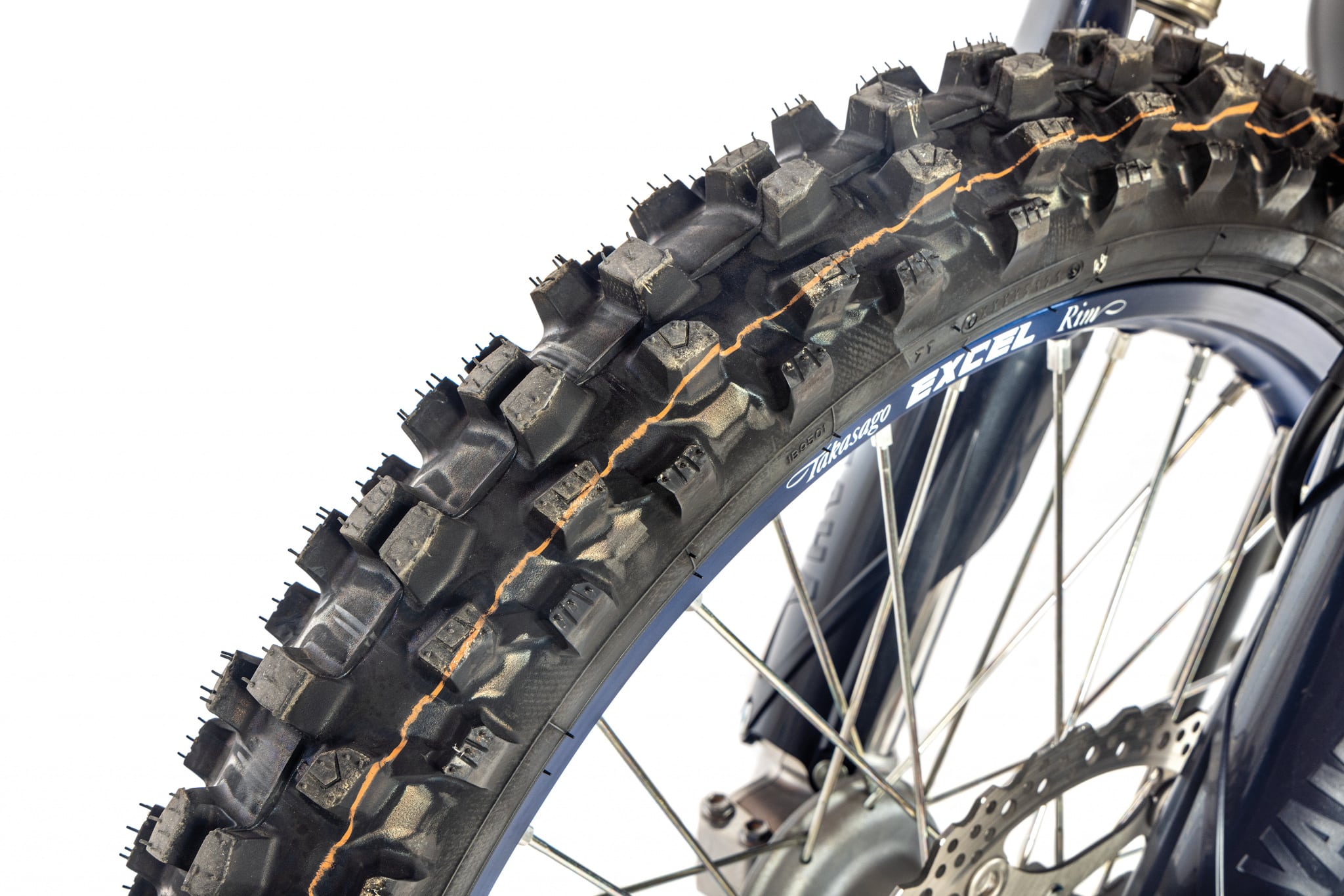
Q: WHAT DID WE LIKE?
A: Here’s a list of things we liked.
(1) Maintenance. MXA has never believed that two-strokes are more reliable than four-strokes, but we have always believed that when engine trouble rears its ugly head, two-stroke parts are four times cheaper.
(2) Brakes. Going fast down a straightaway is only good if you can slow back down to make the upcoming corner smoothly. The YZ250 brakes are good, but Brembo brakes are better.
(3) Seat. The new seat comes off with one 8mm bolt that’s covered by a plastic guard and is located in the rear of the seat—nice!
(4) Price. At $7899, the YZ250 costs $100 more than it did last year and $400 more than it did in 2021, but it is $450 cheaper than the GasGas MC250, $1050 less than a KTM 250SX and $1150 less than the Husqvarna TC250.
Q: WHAT DO WE REALLY THINK?
A: From a performance point of view, there is not much to crow about on the 2023 Yamaha YZ250. Yes, it did get a much-needed facelift. The new looks and sleekness of the bodywork are cleaner and more user-friendly. On the downside, the lack of engine upgrades or weight savings mean that, power-wise, the new YZ250 is really just a spiffed-up 2021 YZ250. That it can still run with the all-new, fuel-injected, electronic-power-valve, electric-start, hydraulic-clutch, Brembo-braked 2023 KTM 250SX proves how good the YZ250’s genes are.
MXA’S 2023 YAMAHA YZ250 SETUP SPECS
This is how we set up our 2023 Yamaha YZ250 for racing. We offer it as a guide to help you find your own sweet spot.
KAYABA SSS FORK SETTINGS
When we first received the bike from Yamaha, the suspension was firm, so we originally went out on compression to soften up the forks. But, after the bike broke in, the forks started pitching the bike forward when they dove. To compensate, we closed up the compression and rebound to get better hold-up. For hardcore racing, this is what we recommend on the 2023 Yamaha YZ250 (stock clickers are in parentheses):
Spring rate: 4.4 N/mm
Compression: 10 clicks out (14 clicks out)
Rebound: 6 clicks out (9 clicks out)
Fork-leg height: 5mm up
Notes: The updated fork settings were more finicky than on previous Kayaba SSS forks. Most test riders in the 160- to 190-pound range slowed the rebound and compression down to lessen pitching. Our featherweight riders went softer than stock.
KAYABA SHOCK SETTINGS
Test riders in the 160- to 190-pound range felt comfortable with the stock settings once we got the forks to feel better. Light riders went out on high- and low-speed compression, but most of our testers stuck with the stock settings. For hardcore racing, we ran this setup on the 2023 Yamaha YZ250.
Spring rate: 50 N/mm
Race sag: 105mm
Hi-compression: 1-1/8 turns out
Lo-compression: 9 clicks out
Rebound: 8 clicks out
Notes: The shock doesn’t do anything funny. It tracks straight and is in tune with the bike. We love this shock.
2023 YAMAHA YZ250 JETTING
The Keihin PWK carburetor has come stock on the YZ250 for a very long time, and the settings haven’t been changed since the N3EW needle was added in 2007, but the 2023 YZ250X cross-country model got a new and slightly leaner NYHW needle. How does the 2023 Yamaha YZ250X cross-country model get away with going leaner when the YZ250 motocross version would ping if it got any leaner? That’s simple. Compared to the YZ250 motocross model, the YZ250X’s cylinder head has its compression ratio reduced from 8.9:1 to 7.9:1 (by increasing head volume from 21.5cc to 23.6cc). Additionally, the ignition timing has less advance in the mid-to-high range. It’s safe to say that Yamaha has the base setting dialed in for the YZ250. This is what we recommend for hardcore racing (stock settings are in parentheses).
Main jet: 178
Pilot jet: 50
Needle: N3EW
Clip: 2nd line from top
Air screw: 1 turn out
Notes: If you hop up your YZ250 with engine upgrades or a pipe, you might have to go to a bigger 180 main jet or add VP C-12 fuel in a 50/50 ratio with pump gas. Also, the air screw is very sensitive between a 1/2 turn and 1 turn out.



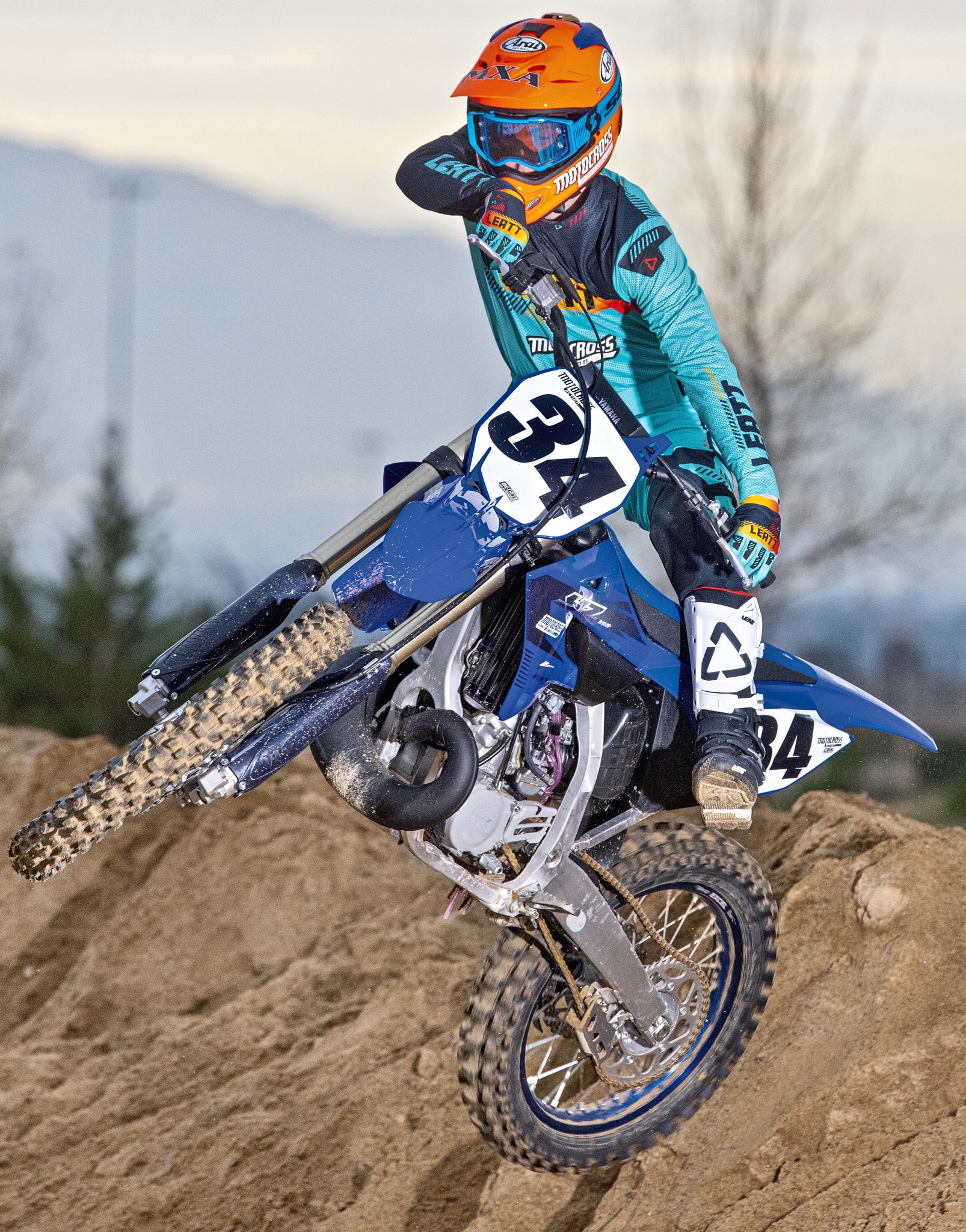
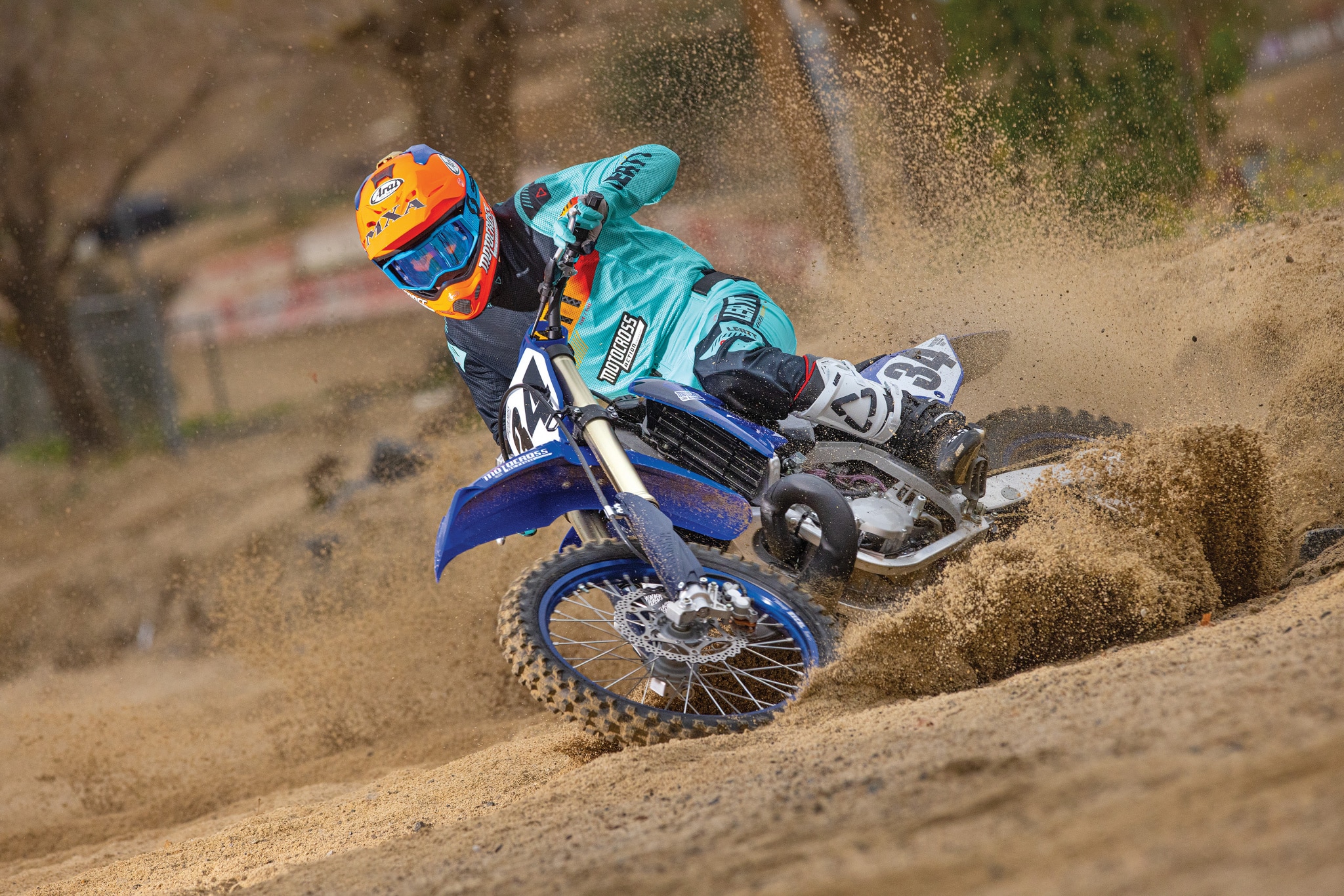




Comments are closed.